Created by Nicolas Caminero, Isabelle Lee, Daniel Donghun Kim, and Annabelle Wang
Artist’s statement
We designed Dynamite Duos to get friends and strangers of all ages to get comfortable with each other quickly. We specifically wanted to create a simple game that could be understood easily and played quickly, adding to the spontaneity of a fun party setting. During our brainstorming sessions, we discussed games that brought us together with our friends and found a common ground: a healthy dose of time pressure to keep things moving, along with a balance between competitive and cooperative play.
Inspired by the idea of building community, we added some mechanics we hoped would do the trick. Players would be paired up in order to complete the challenge stated on the card, and other players would be able to sabotage them by guessing the answer before the current team. We hope groups of friends and acquaintances play our game together at parties time and time again, building up a sense of competitiveness and community.
Concept Map
A card is drawn, the dynamite is passed, and the guessing and acting begin! This is the core loop of the game.
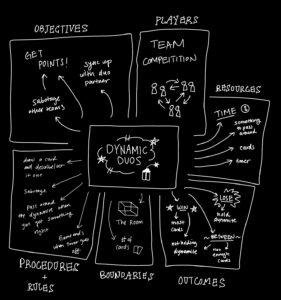
Formal Elements
Current Decisions
When we first discussed the elements of Dynamite Duos, we wanted to create a modification of Hot Potato with an added challenge. Guessing games that incorporated words, sketches, and acting came up when we discussed what exactly that challenge could be. Namely, Dynamite Duos encourages players to (1) challenge themselves through gameplay, (2) build companionship with their teammates, and (3) play a simple game for many rounds.
(1) Challenge Themselves
For players to earn cards, they must get their partners to correctly guess the word. However, each card will contain a list of “forbidden words” that are closely related to their drawn word but are not allowed to be said. They serve as obstacles that prevent them from earning the card. But at the same time, it causes players to think of other creative ways that can get their teammate to guess the word!
(2) Build Companionship
Each player will be paired with another player. During gameplay, players must come up with an explanation to have their partner guess their drawn word as quickly as possible. To do so, it would be best for them to know their partner and any possible associations they may have with the word. Using these tactics, we strive for our game to promote fellowship between team members.
(3) Play an Easy-To-Learn Game
Since we were creating a social game, we did not want to make our game too complicated. Our goal was to create a simple but engaging game that anyone could learn in a matter of minutes. This way, people at social gatherings could pick up Dynamite Duos and start participating in a fun activity with minimal instruction.
Initial Decisions
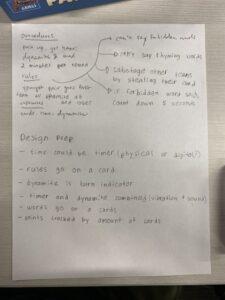
The image above shows how we broke down each formal element when we were first developing our game. Briefly, we’ll walk through our thoughts in more depth.
Players: Most guessing games we as a team had seen in shows and had played personally included pairing individuals up instead of pitting every individual against each other. This was successful in the final version of the game!
Objectives: The objective of each duo is to sync up and get the most points. In order to get a point (a playing card), players (the actor) must describe their word without saying any forbidden words/act it out for their teammate (the guesser). If the teammate guesses correctly, the duo gets the card! The team with the most points wins!
Rules and Procedures:
-
- The youngest team (sum of the ages of both team members) will go first.
- The duo that is currently guessing must be holding the dynamite.
- Actors cannot say forbidden words when describing their word.
- Players will choose a moderator (if odd number of players) or two people to moderate (if even number of players) who make sure that forbidden words are not used.
- Players were allowed to use words and actions to get their teammates to guess the card
- Duos can also sabotage and steal cards if they guess the word correctly before the current duo does.
- More detailed rules are provided in the printable rules sheet PDF at the end of this post.
Resources: Our game will include a deck of cards and a rule book. Players will provide their own dynamite and timer. The most crucial resource of all, obviously, is time. 😜
Boundaries: The players are bounded by the number of cards in the deck and by the set round time of 3 minutes. There are no explicit spatial boundaries, though it is best played when players are gathered in a circle and close enough to hear everyone else.
Outcomes: At the end of the game, the team with the greatest number of cards wins. The team holding the dynamite loses. If a team fulfills both of these conditions, they must forfeit their winning position which now goes to the team with the second-highest number of cards.
Iteration History
We are thankful to have had many opportunities to playtest our game in class with our peers. Below, we’ve gone through our three prototype and playtesting iterations, detailed below.
Iteration 1: Initial Idea and Challenge
We playtested with 6 people in class for our first playtest. We used hand-drawn index cards with words and forbidden words as lo-fi playing cards.
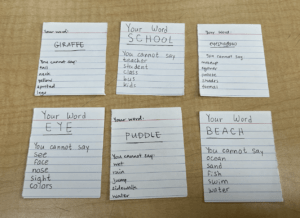
We found that the players enjoyed the game and found the sabotage mechanics particularly engaging. The challenge seemed to be challenging enough for players, which is what we wanted to answer.
However, some players would try to sabotage, guessed incorrectly, and were not penalized because the moderator was paying attention somewhere else. We also quickly discovered that the playtime for this game felt too long for players. Because there were three teams, we ran the game for 6 minutes. Players kept asking what the time was and someone even asked “So when is it blowing up?” They didn’t feel like the situation was “hot” enough to be stressed in.
There would also be some confusion within duos as to who would act and who would guess, which we attempted to edit in our next iteration.

Edits:
- To make the game more fast-paced, we decided to reduce the playtime from the (#pairs * 2) to 2 minutes for our next playtest.
- We also decided to add that a duo that wants to sabotage must say the word “sabotage” loudly before guessing, or else their guess would be invalid. We hoped this would increase social pressure to own up to one’s failed sabotages, or at least make it more obvious when someone failed to sabotage so someone else could point it out and get them penalized.
- Also added that duos should designate who the actor and guesser should be before the start of each round.
Iteration 2: Time
Unfortunately, we don’t have any pictures from this round of playtesting. However, we still got some good insights!
In this round, we playtested with 4 players. We added the edits we mentioned previously and also printed out the rule sheet ahead of time to see if it was comprehensive enough. Our biggest question this round was if 2 minutes worked to make the situation more stressful/challenging for the players (which it definitely did!).
However, we found that our game rules were not as clear as we would like. Some players didn’t understand the sabotage mechanism when explained at the beginning of the playtest either.
Edits:
- We went back to the drawing board together as a team to rewrite the rule book to be more concise and engaging for players to read before the game started.
Iteration 3: Testing Iteration 1 in More Depth
In this round, we playtested with 4 players. This was a slightly longer playtest, as we had much more time than in our previous two rounds. We mainly wanted to test if our insights and edits from iteration 1 made gameplay more challenging and clear for the players now. Specifically, our biggest question this round was if 2 minutes actually made the situation more stressful/challenging for the players, which it definitely did!

We found that players loved the shorter time — the situation heated up more quickly with some really funny descriptions as players struggled to think of words as the time went down. However, the playtesters mentioned they would even prefer a slightly longer time for each round. While each round was quick, they found that the game was more fun the longer and faster it was played.
We also found that our minimum number of players might have been too low. We previously stated that we only needed 4 players to start the game, but our playtesters mentioned that this made the scoring mechanism more confusing because there was no longer any need to track card points — the team holding the dynamite lost so the other team automatically won.
Most interestingly, we encountered some cool edge cases! Players and CAs expressed concern about a team deliberately not guessing the correct word until the very last second in order to get the dynamite off their hands. We thought the sabotage mechanism would fix this — if a word was already too easy for the guesser to know, another team would have already tried to sabotage them. However, we still thought this might not be enough. We had another case where a playtester said she would just describe her words more quietly so that other teams would not hear. This meant we needed some best practices!
Lastly, there was a case where two teams said the answer at the same time, so it was difficult for the moderator to distinguish who had said it first. This meant we needed some tie-breaking mechanisms, all listed below.
Edits:
- Increased round time to 3 minutes.
- Increased required number of players to 6+.
- Tie-breaker between current duo and sabotaging duo — if both teams say the correct word that the same time, the sabotage team takes priority. Why? Sabotaging is a riskier behavior since the sabotaging team gets the dynamite if they guess incorrectly. The sabotaging team must also say the word “sabotage” before guessing, so it technically would mean that the sabotaging team knew the answer first.
- Included best practice strategies to induce social pressure and play the game the way it was intended.
Iteration 4: Final Touchup
Based on the results from Playtest 3, we decided to add the charades mechanism to cards to make the game more dynamic and to make our game less like the word game Taboo. Now there are ‘Show Cards’ on top of the ‘Tell Cards’. The two decks could be mixed or played separately, based on player preferences. Initially, the reason that we went with word-based descriptions was that we thought that people may be too shy to act in front of people that they do not know too well. We concluded that if people can play Cards Against Humanity or Drawing without Dignity with people that they do not know too well, Dynamite Duo with charades can definitely be played as well!
We also modified the previous 5-second penalty rule for sabotage from 5 to 3 seconds. Everyone agreed that 5 seconds might be too long given that each round was only 3 minutes.
Final Playtest Video
Final Prototypes
Print To Play Prototypes
Final Mockups
- Box Design
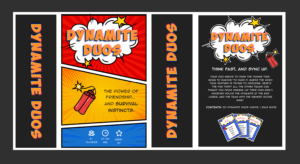
- Cards
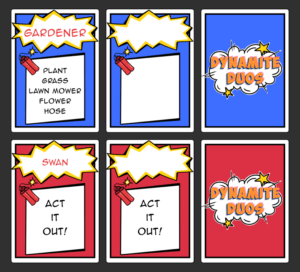
- Rulebook
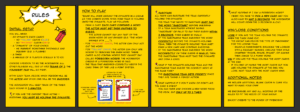
Conclusions and Learnings
We learned many things within the span of this short design sprint. In terms of team dynamics and work, we found that meeting in-person for several intense hours worked best in terms of output. Regarding the design process, we learned the importance of numerous playtests and revisions. Though it seems obvious that playtests are more accurate when we take a more hands-off approach and let people play our game with less direction on our part, it is slightly more difficult to put into practice – it’s easy to want to jump in and steer people in a certain direction, but letting go of those expectations made for a much more honest game and debrief as a team.
Signing off,
Team 21




